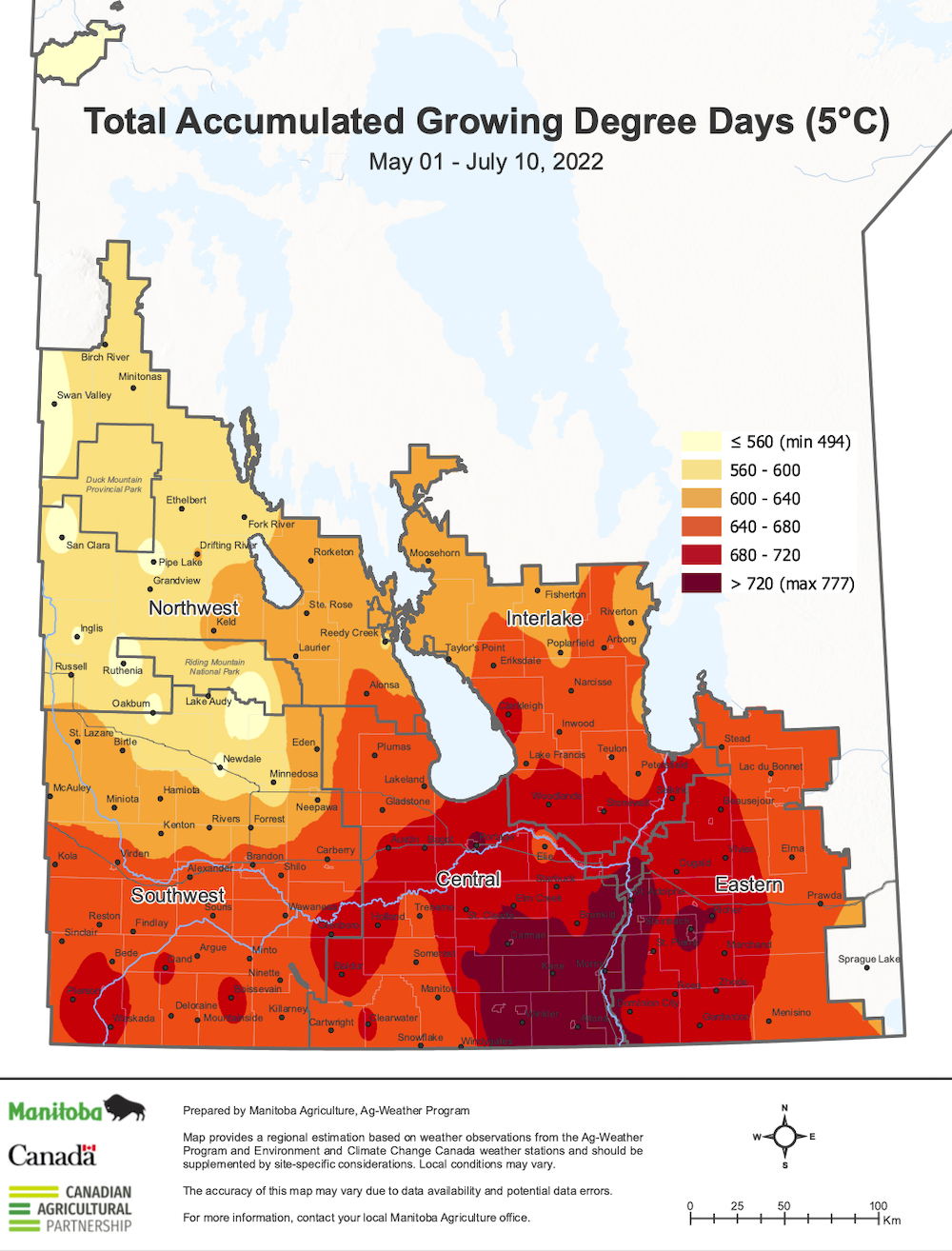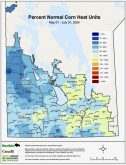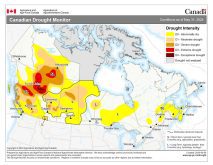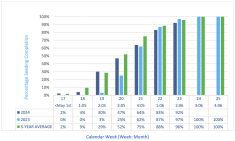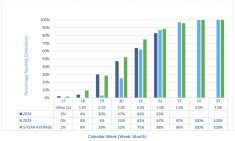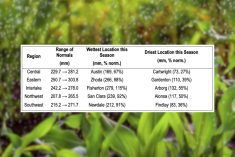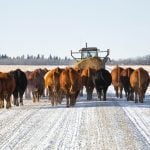Overview
Crops have advanced rapidly across all parts of Manitoba this past week, faster than many agronomists had expected. Rapidly growing crops have hastened crop flowering, and cereal and canola fungicide application is well underway.
Warm temperatures, high humidity, and rain in recent days has increased the risk for fusarium head blight and sclerotinia disease development in crops, and most farmers are choosing to use a preventative fungicide on spring cereals and canola. Spraying is also expected to begin in flax fields shortly, and continues on field peas for for mycosphaerella.
Read Also

Manitoba Ag Days 2026 coming up fast
Canada’s largest indoor farm show, Manitoba Ag Days, returns to Brandon’s Keystone Centre Jan. 20-22, 2026. Here’s what to expect this year.
Scattered and widespread rainfall last week slowed in-field herbicide and fungicide application by ground, and many farmers are choosing to spray fungicides by air this year, to reduce rutting on soft fields.
Despite good growing conditions, heavy rains have damaged crops, leaving large drowned out spots and the wet spring delayed seeding by over a month. Crops have caught up somewhat, and still look behind normal in many areas of Manitoba.
Cereals
Earlier-seeded spring wheat crops are fully flowered, most are now at head emergence. Crops in the Northwest are a little further behind, from jointing to early head emergence.
Fusarium Head Blight risk maps showed high to extreme risk over the past week, due to repeated rains and humid conditions right as the crop is reaching the flowering window.
Widespread fungicide application is ongoing on nearly all farms as a preventative measure against fusarium head blight infection.
Fall rye and winter wheat crops are at the milk to soft dough stage. Some bacterial leaf blight was observed on flag leaf winter cereals.
The majority of barley and oat crops have reached are at flag leaf across the province, while the earliest barley crops in in the Red River Valley (Central/Eastern region) are headed out.
Fungicide application on flag leaf is ongoing for oat crops.
Grain and silage corn has put on a huge amount of growth in the past week, and looking quite good. Some fields do appear nitrogen-deficient due to rapid growth and heavy rains leaching some nitrate to inaccessible depths in saturated areas.
Grasshopper spraying is occurring on an as-needed basis, typically in crops where populations were
extremely high last year. Feeding damage is limited so far.
Oilseeds
Canola crops range from 4-leaf to full (50 per cent) bloom stage, with the bulk of the crop expected to reach 20 per cent bloom in the next few days, reaching the threshold for fungicide application.
Canola crops are extremely variable in many districts – due to seeding date, flea beetle pressure, reseeding, and environmental conditions. Water stress is causing leaf-cupping in some crops on slower-draining land with recent heavy rains, while others are lush and in full bloom only a few miles away.
Canola fields that were stressed throughout the spring are starting to bolt – more as a stress response than reaching the maturity threshold. Late-seeded crops generally look good, but there are many “hit or miss” fields across all regions. Crops have improved in condition from two weeks ago, but remain uneven.
Lygus bugs are noted in many canola crops, scouting for presence at threshold levels is ongoing. Blister beetles are commonly found in flowering canola in the Southwest.
Flax crops are growing rapidly and generally range from bud development through early bloom. Flax stage varies widely depending on seeding date and region, but most fields are between 8 to 10 inches tall (20 to 25 cm).
Flax crops in areas with excessive rain and slow draining fields are struggling. Some heat canker was reported in fields that were emerging through the late June heatwave.
Sunflowers are now at V7 to R1. Sunflower crops appear in great condition, despite some weed issues.
Pulses
Soybeans are growing rapidly with recent warmer weather, more heat is required in the Northwest region to push crop development. Canopies have closed on solid-seeded fields, as plants reach V5 to R1.
Iron-deficiency chlorosis (IDC) has been showing up in soybean crops this past week, most noticeable on more susceptible varieties, and even those with tolerance to IDC on the newest leaves.
A few reports of soybeans aphids being found south of Fannystelle in the Central region, but no spraying has occurred.
Some grasshopper feeding noticed on soybean crops, some spraying has occurred.
Field peas have moved into reproductive stages, earliest crops are advancing to beginning pod formation
in the Northwest region, while most other crops are between R1 and R3 (full flower).
Producers and agronomists are urged to scout peas using the foliar fungicide decision tool to control
mycosphaerella blight, fungicide applications are ongoing.
Pea aphids are present in many fields, some insecticide application has started, notably west of Morden
over the escarpment.
Bacterial blight has been reported on dry edible beans, where wind damaged plants. Generally dry bean
crops look good. Variable crops in the southern part of the Central region wherever rain was in excess.
Forages & Livestock
Forages
Hay cutting by dairy and beef producers continues to be hampered by wet, humid weather. Field surfaces are soft, and subsurface moisture is making ground travel a challenge.
Yields are estimated between 2 to 3 bales/ac at 1,300 to 1,400 lb bale weight, regrowth has been very good.
Late-seeded greenfeed has been planted on previously unseeded acres in parts of the Northwest and
Interlake regions.
Concerns persist about not being able to take a second hay cut in areas where wet weather has prevented a first cut, or baling the existing cut to date.
Pastures are able to outgrow grazing pressure, some pastures have grass heading out.
Livestock
Producers are generally happy with pastures at this point, and are hoping for an extended grazing season, especially if they are unable to put up enough hay due to excessive moisture.
Some producers have reported increased cases of foot rot and pink eye due to wet conditions.
All creeks, streams, dugouts, and sloughs are full and water supplies are sufficient.
Regional Comments
Southwest
Rain showers fell in different locations across the region over the course of last week. Some pockets had more moisture compared to others, and isolated hailstorms damaged crops, but was not very significant. Rainfall amounts varied, ranging from 10 to 30 mm to 50 mm at Minnedosa and 75 mm at Shilo. Crops look very good in general, but late. There are still some low spots that have standing water and have drowned out, but for the most part, crops are thriving with the better weather.
Rain slowed down spraying progress again, though most producers are close to finishing. Many producers are looking at fungicide application as crop starts to reach the correct stage.
Northwest
Mixed weather brought heat, high humidity, and severe thunderstorms across the region last week. Frequent rains continue to drown out acres in the Dauphin, Fork River, Grandview, Ste. Rose du Lac, and Laurier areas, in addition to acres already drowned out or left unseeded. Rain was welcome at The Pas. The Roblin to Inglis areas received the most rain this past week, between 25 to 33 mm. Localized showers brought rain not recorded on official weather monitoring networks.
Crops in the areas listed above are almost a month behind crops in other parts of the region. Cooler weather in the Northwest than other parts of Manitoba has led to less Growing Degree-Day accumulation, generally between 86 and 98 per cent of normal.
Central
Supercell thunderstorms brought localized intense rainfall to some areas last week, with hail falling north of Plum Coulee in a small band early Monday morning. Crops have rapidly advanced, where nearly all crops are reaching reproductive stages, and fungicide application is underway on flowering wheat, barley, canola, and peas. Foliar flag-leaf fungicide continues on oats.
Insecticide applications have slowed, with the occasional soybean or cereal field sprayed for grasshoppers. Fields have received abundant rainfall, and crop roots are somewhat shallow in fields where moisture is easily accessible. Corn growth has been the most noticeable, and canopies are closing on 30 inch rows. Canola is reaching 20 to 30 per cent bloom in about half of canola crops, most noticeable from Carman south to Winkler. Crops further north have received more rain, and delays in seeding mean they will bloom in another week to 14 days.
Eastern
Rainfall accumulations last week across the region varied from 9 to 33 mm, with most locations reporting between 10 to 20 mm. Standing water still persists in low lying areas of fields and pastures. Warm temperatures saw a rapid increase in crop growth, but crops in standing water continued to see plant stress and drowning death.
Herbicide spraying is done, and fungicide application is underway on cereals. Many fields are being sprayed by air due to wet and soft field surface conditions. First cut haying is approximately 45 per cent complete, with dairy producers already finished.
Interlake
Rains continue to damage infrastructure and crops in the northern Interlake. Some farmers are reporting nitrogen deficiency corn, where excessive rains have led to poor root growth, nitrogen leaching, and lack of good growing conditions for stressed crops. Hail and heavy rain fell in the Balmoral area last week, damaging crops there.
Approximately 85 per cent of herbicide application is complete, some reseeded or very late seeded fields remain. Fungicide application will be sporadic in the northern parts of the region, while southern areas have generally seen better crop growth and farmers see value in spraying a preventative fungicide.

